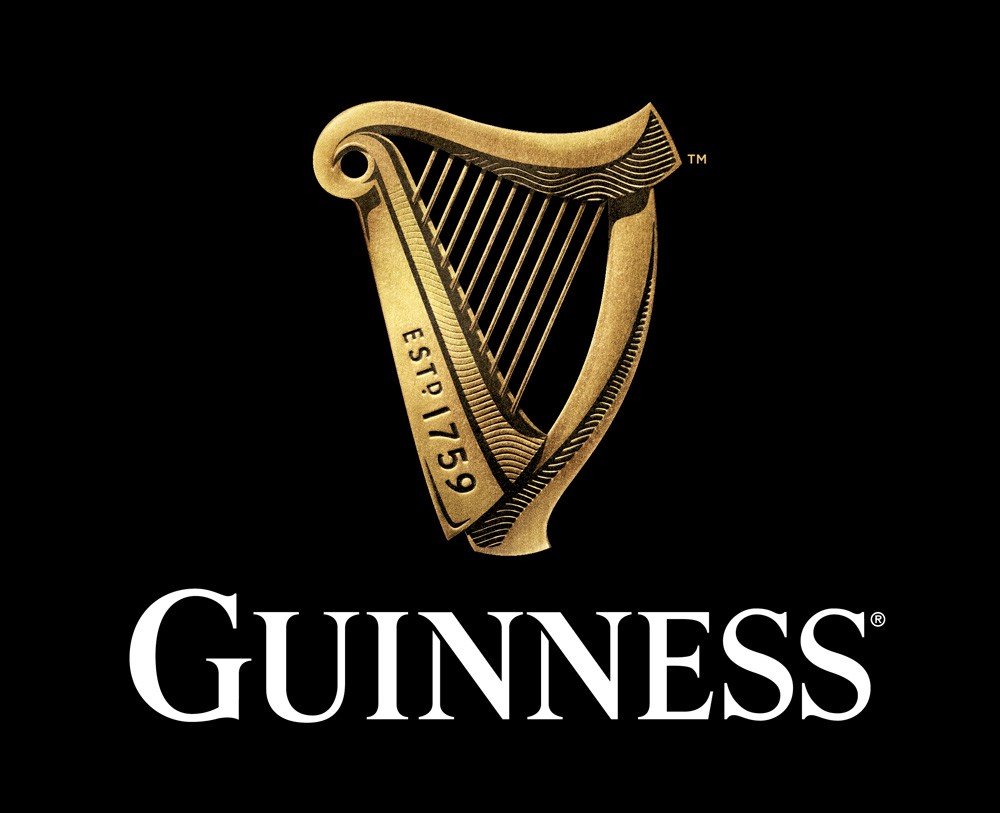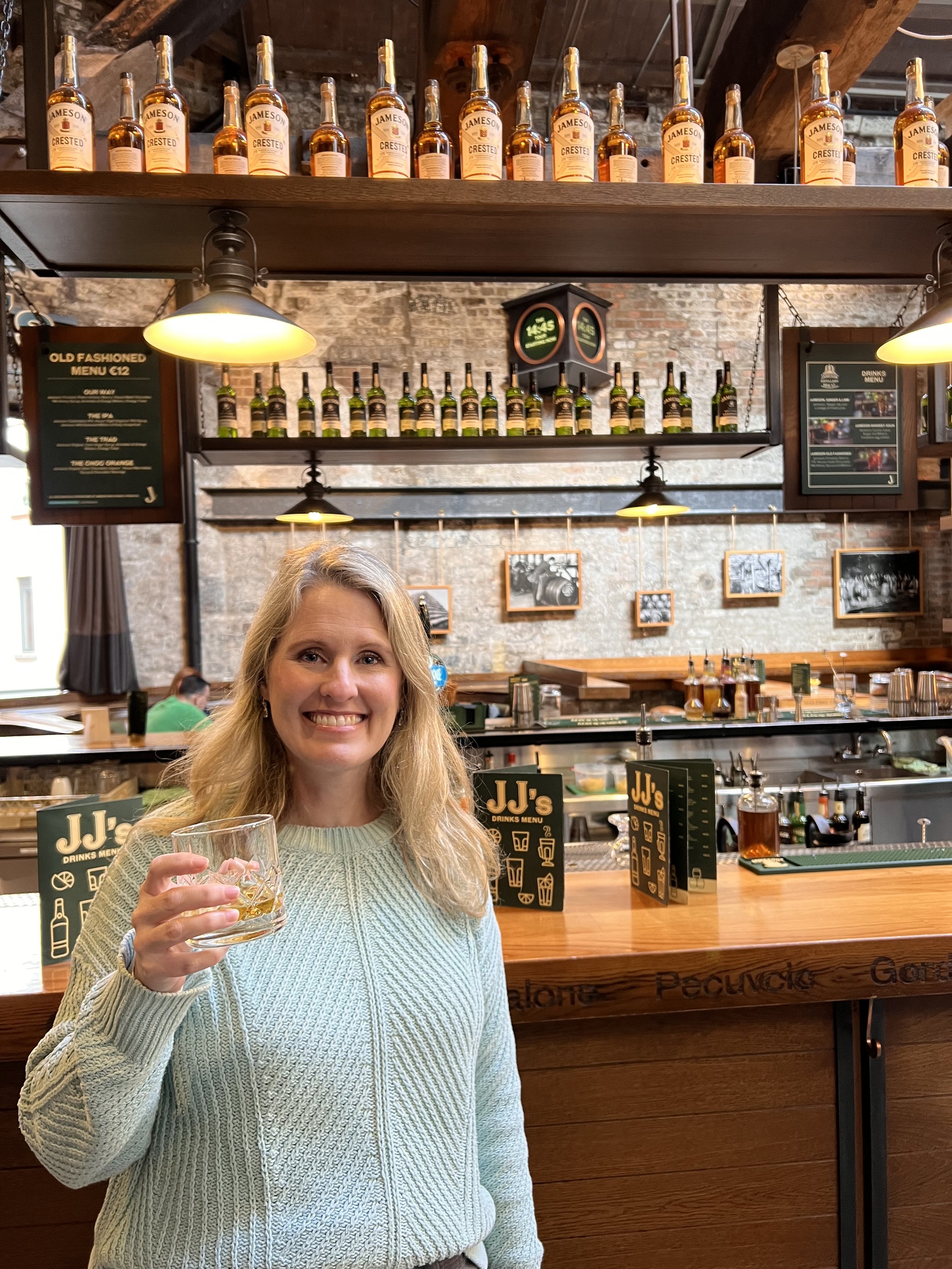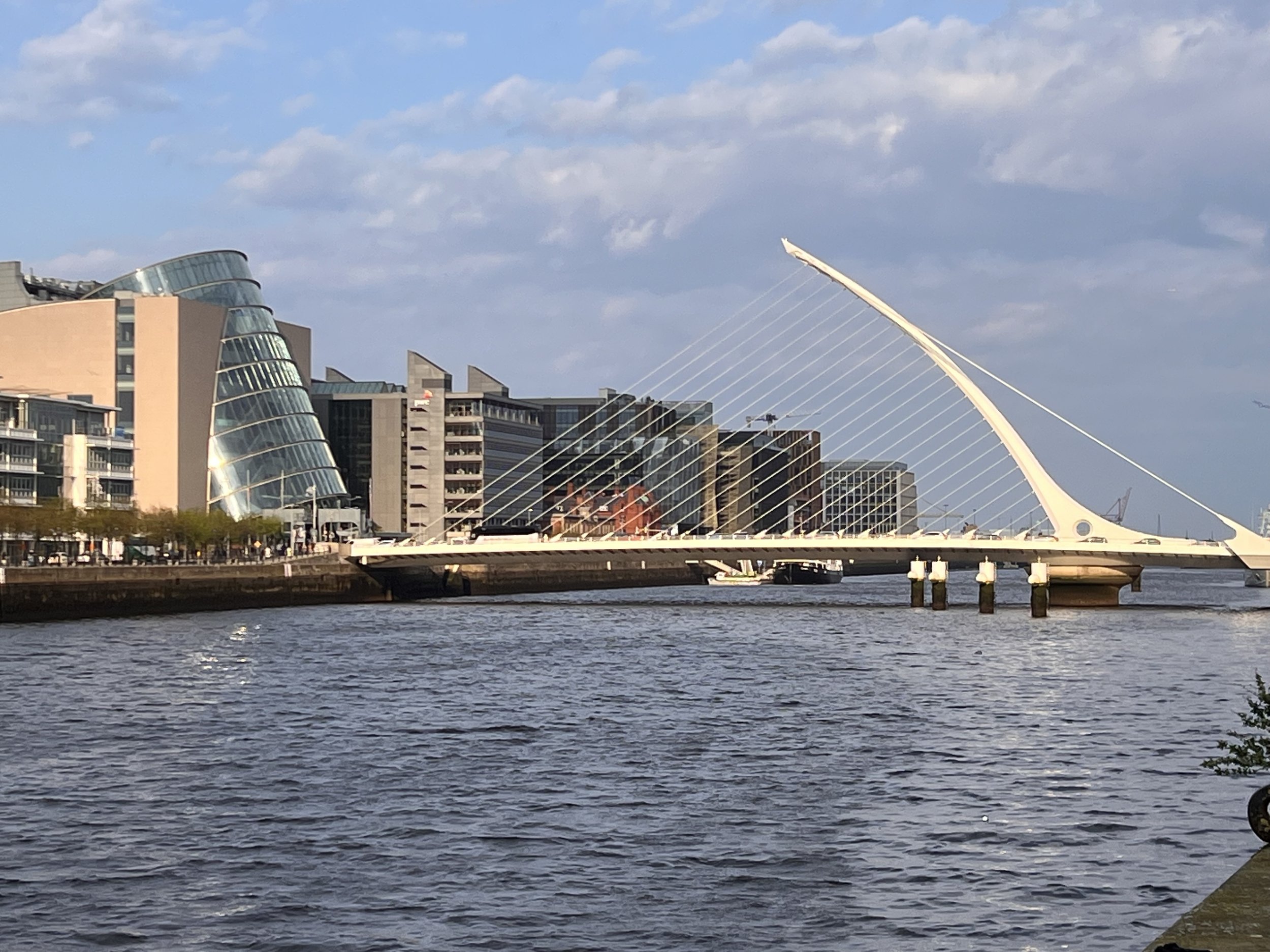Céad Míle Fáilte
When immersed in a place of tranquility, you never want it to end. But the spell was broken by the alarm on Sunday morning (Apr 16), and we began the three-hour drive to the ferry terminal in Holyhead, Wales—where we would embark on the next leg of this wild and wonderful journey.
Céad Míle Fáilte (kay-od mee-leh foyle-cha) is a much loved Irish greeting and welcome that translates to “a hundred thousand welcomes.”
“IRISHMEN AND IRISHWOMEN: In the name of God and of the dead generations from which she receives her old tradition of nationhood, Ireland, through us, summons her children to her flag and strikes for her freedom.”
The process couldn’t have been simpler. Book your tickets online, drive up and wait in line, check-in at the drive-up kiosk, wait a little longer in another line, and then drive onto the massive ferry. Easy peasy lemon squeezy, as the Brits would say.
By the time we arrived in Holyhead, it was really foggy.
About to drive on to the Irish Ferries boat Ulysses.
With the car parked on the Copper Deck, it was up to the lounge. We started with a tea and mocha from the onboard Café Lafayette and a curry from Boylan’s Brasserie, browsed the Duty Free store, and then read in the aptly named James Joyce Balcony Lounge. It was a really pleasant way to travel, far easier and more comfortable than by air.
On the deck.
Not much to see and pretty 🥶
A little over three hours later and we were pulling into Dublin Harbor. Ireland welcomed us with sunny skies!
We drove off at Port Dublin and began to panic. Ever since our arrival in port, and as we slowly made our way to the Passport Control kiosk, we couldn't get our cellular data to work.
Having been forewarned about the difficulty of driving in Dublin with its traffic, bus-only lanes, taxi-only lanes, and a labyrinthine of one-way streets and narrow alleyways—the prospect of not having Google Maps to guide our journey was freaking me out.
We successfully passed the Passport Officer’s questions and I began slowly following the signs out of the port to City Centre, all the while trying to diagnose why we couldn’t get internet service. Were we going to have to go old school on this one?! Get a map 🗺️ ? Repeatedly stop and ask for directions?
Amanda read something aloud that triggered a memory for me that we had purposely turned roaming off in our cellular settings—and that was the ticket! Vodafone, our UK cellular provider, includes service in Ireland at no charge; however, it is considered roaming. Phew! 😅 Crisis averted. Thank goodness there was traffic; it gave us time to work through the issue.
Thankfully we had also completed several dry runs using the videos provided by the owner of the apartment and Google Earth Street View. Because of this, I recognized the tiny alleyway I otherwise would have missed. I then let Amanda out so she could to walk to retrieve the key and then make her way through the crazy maze of the apartment complex. Once inside, she was able to call a number that allowed the gate to open so I could drive into the underground garage.
It was an quite the process, but I’m proud of us—it took some great teamwork between leaving the boat and getting settled into our new Dublin digs.
Our apartment is located right next to the famous Ha’penny Bridge. The name derives from the cost to cross the River Liffey by ferry before the charming pedestrian bridge was installed in May 1816. We crossed the bridge and had dinner at Milano, Ireland’s branding of Pizza Express.
The sun setting over the River Liffey from the Ha’penny Bridge. Time to settle into Dublin.
A Walk Through Dublin
On Monday morning (Apr 17), it was off to the Guinness Factory and some sites along the way, like these figures on the Grattan Bridge.
Christ Church Cathedral
A covered bridge over a road is always cool, but an arched passageway connecting parts of a cathedral is even cooler.
St Audoen's Catholic Church
John's Lane Catholic Church
St Patrick’s Cathedral
Amazing spires atop the buttresses and main cathedral walls.
The Police in Ireland
Fusilier's Arch at the entrance to St Stephen’s Green.
Blossoming cherry trees.
232° Celsius
The exact temperature at which Guinness barley is roasted to give their stout the unique color, amazing roasted coffee and chocolate aroma, and flavor we all love.
“We are brewers and always have been and in our view we have sought, and we seek, to ally the traditions and craftsmanship of the past with the best that science has to teach us.”
The entrance to the Mecca of Stout.
The original lease to Arthur Guinness in 1759 at £45 per year for 9,000 years, encased in glass on the floor at the center of the building.
On New Years Eve, 1759 Arthur Guinness signed a 9,000 year lease on a run-down building in the neighborhood of St. James’s Gate, Dublin. Guinness had run a small brewery back at home in County Kildare, but at the age of 34, Arthur wanted to try his luck in the country’s capital.
The 9,000-year lease might have seemed a risky move to some, but it quickly became abundantly clear that the bold move paid off. The St James’s Gate area has been the home of Guinness ever since.
Arthur Guinness’s signature from 1759 that still appears on all their labeling.
The massive waterfall feature designed to emphasize the high value Guinness places on the quality of the water used in the production of their beer.
In 1784, Arthur signed a 8,795-year lease where he agreed to pay an extra £10 annually to ensure a supply of water from the Wicklow Mountains.
Our first taste. Later we learn to pour a proper pint and get to drink a real pint, not some baby sippy Guinness.
Arthur Guinness
The harp has been synonymous with Guinness since 1862, 46 years before a version of it became the official national emblem of the Republic of Ireland.
The Guinness harp is a depiction of a medieval Irish instrument known as the O'Neill or Brian Boru harp. Currently housed in Trinity College Dublin, the original was made around the 14th century, although the identity of the craftsman and their patron remain lost in the mists of time.
The Downhill Harp (1702)—This famous instrument (above), with provision for 30 strings, was made by Cormac O Kelly of Ballynascreen. The box is cut from solid sally, with the lower portion curiously divided and inswept. It’s on display as part of the factory tour.
Guinness first adopted the image in 1862, so when the 1922 Irish Free State Government chose it as the symbol of the nation, they had to use a mirror image to avoid trademark issues. In honor of the now world-renown logo, Guinness named it's first lager Harp in 1960.
The national symbol for Ireland
Amanda pours her own pint following the Guinness Two-Part Pour:
Use a Guinness-branded glass with the harp logo.
Aim the spout at the harp, at a 45° angle.
Pull the spout toward you and pour until the glass is ¾ full (to the top of the harp logo).
Let the beer surge, or cascade. According to Guinness, this process takes exactly 1 minute and 32.5 seconds.
Top off the pint by pushing the tap handle forward.
Serve the beer with the logo facing toward the drinker.
In 1959, Guinness was the first brewer to introduce nitrogen into beer. It takes 300 million tiny gas bubbles to achieve the super smooth mouthfeel and iconic creamy white head. It's also the secret behind Guinness Draught's “surge and settle,” the unique cascade of bubbles which every proper pint of Guinness must have.
All topped off. We are now genuine experts!
The Guinness mustache.
Enjoying some of Guinness’s other offers in the Gravity Bar, sitting high above Dublin’s historic rooftops. Such an amazing view!
From the Gravity Bar, the Wicklow Mountains stand in the distance—the source of Guinness’s pure water.
Trinity College
On Tuesday we visited the Trinity College Dublin campus. The Campanile was built in 1853 to the designs of the famous Belfast architect Sir Charles Lanyon. It stands nearly 100 feet tall and has become one of Dublin’s most iconic images. (The student believe if they ever walk under the monument they will be cursed and will fail all their exams.)
Hey Big Bang Theory TV show lovers: in 1943, Erwin Schrödinger, the Nobel Prize-winning physicist, then Director of Theoretical Physics at the Dublin Institute for Advanced Studies (DIAS), gave three public lectures entitled “What is Life?” at Trinity College Dublin. It was in this building that he first revealed the thought experiment known as Schrödinger’s Cat.
Following a campus tour, we visited the Book of Kells exhibition inside the Old Library. The Book of Kells is a lavishly decorated copy, in Latin, of the four gospels of the life of Christ. The Book of Kells has long been associated with St Colum Cille, who was born in 521 or 522 in Donegal into the ruling dynasty of the Un Neill (an Irish dynesty). He founded his principal monastery on the island of Iona, off the western coast of Scotland, in about 561. The Book of Kells probably dates from the early 9th century, and may have been begun on Iona, where we’ll be visiting in June.
The absolutely amazing Long Room in the Old Library at Trinity College Dublin.
Inside the Old Library is the original Brian Boru harp—the oldest surviving Irish harp. It is the model for the Guinness logo and the insignia of Ireland.
Just walking through the mall…we really are in Catholic territory!
The Spire of Dublin.
The Craic is Mighty
Craic is an enjoyable social activity; a good time.
The Temple Bar is a Dublin icon. Amanda read that while the bar may be crowded, filled with nothing but tourists, and overpriced, it was still not to be missed. The article was right.
The walls inside the pub were covered in police and fire patches from across the USA. I found one of particular interest.
A little piece of free advice…something that would have saved this culturally-ignorant traveler some embarrassment: never order a Black and Tan while in Ireland! Yes, I did! No, I shouldn’t have! (I asked for one in the Guinness Gravity Bar too! 😬)
Historically, the Black and Tans were a force of Temporary Constables recruited to assist the Royal Irish Constabulary in maintaining control over the IRA during the Irish War of Independence. They were generally thought of as the scum of the British system—looking for British ex-soldiers turned psychopaths, turning them into an evil, murderous militia, and releasing them from jails into Ireland.
While recent findings may suggest some historical inaccuracies in this description, that will do nothing to change the minds of millions of Irish who still despise The Black and Tan.
So, don’t be an eejit like me. If you’re in Ireland and you want a pale ale blended with a stout, ask for a Half and Half. They still may look down on you as a British stooge, but at least they won’t throw you out of the pub on your arse. Better still, don’t be a feckin gobshite—just order a feckin Guinness.
Enya (2nd down) and The Frames (3rd down). In honor of The Frames and our visit to Dublin, we re-watched the movie Once and enjoyed watching Glen Hansard (of The Frames) and Markéta Irglová (both previous members of the band The Swell Season) sing their amazing songs. It was also fun to watch the movie after having walked down the very streets where they filmed. Can anyone identify the bottom photo?
Here are some snippets of the music from our time at Temple Bar: Temple Bar Video: https://www.youtube.com/watch?v=Hr2Ig5FOuCE
With beer in our bellies and music in our hearts, Tuesday was a wrap.
By the way, every wonder how a toucan became an icon of Irish Guinness? In the 1870's the Guinness site expanded northwards to bound the River Liffey and in 1873, the Company built their own jetty on the river. This enabled barges to load and unload wooden casks of Guinness directly at the gates of the Guinness Brewery for the first time.
Dublin school boys used to stand on the Ha'Penny bridge (above) calling out “Hey Mister, Bring us back a parrot” at the passing barges underneath, as they thought that the barges were sailing off to exotic places laden with Guinness. It guess it’s a small leap from parrot to toucan. Hmmm. That’s what the display says in the factory tour, but here is another explanation that seems more likely
On Wednesday morning (Apr 19) we stopped at the famous statue very near our apartment. Known as "the Liberator" for successfully campaigning for the right of Irish Catholics to become Members of Parliament, Daniel O'Connell is celebrated by the O'Connell Monument on the street which bears his name.
Is Roads Policing the Garda’s version of a Highway Patrol?
Jameson
“A good story cannot be devised, it has to be distilled.”
We slowly found our way down to the original Jameson Distillery on Bow Street.
Unlike Guinness who has remained in the same Dublin location, Jameson’s distillery activity has all moved to Midleton, Cork. Hopefully, we’ll get to tour that facility as well in a week or so.
We tasted Jameson Black Barrel (left), original (center), and Crested (right). Crested in made in smaller batches and is not in wide distribution, so you cannot buy it in the States. We’ll bring home a bottle! 🥃
Here’s a Jameson Original on the rocks for you Grandpa Clint!
Now that’s a chandelier!
Without Fear
Saw this on the menu and had to try one before we left. The Choc Orange: Jameson Original, dark chocolate liqueur, house marmalade syrup, & chocolate shavings. Delicious! 🤤
I may have been a little “off my game” after all the whiskey, because I willingly walked into this store and bought myself a pair of “work trousers.” Ever since we arrived in the UK (and now in Ireland) I’ve been seeing workers wearing these pants (they say trousers) with tons of pockets. They are made by a Swedish company called Snickers Workwear and I’ve never seen anything like them in the USA. While I was buying mine, we heard another American come in looking for the pants, saying he had never seen them in the US either! Hilarious. It’s going to catch on and I can say I was out in front of the trend! 😂
The Millennium Bridge in Dublin…not exactly on par with London’s version. I wonder who built their’s first 😆
A monument placed by the government of Canada on North Walk. It reads, “In memory of the victims of the Great Famine, and for their descendants who have done so much to build Canada.”
Samuel Beckett Bridge (aka the harp bridge). The unusual building on the left is the The Convention Centre Dublin, probably shaped like a cask if I had to guess.
Looking through the bridge toward Port Dublin.
Thank you Dublin; it has been a blast! Tomorrow we head for Limerick. Here is a quick video of our Dublin apartment: https://www.youtube.com/watch?v=RTp9vo_H6hM




























































































